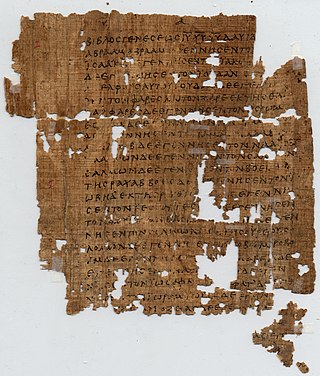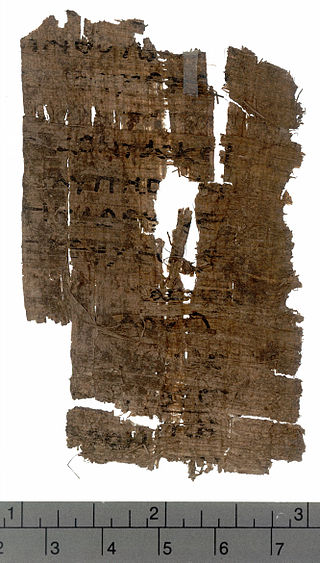Related Research Articles
Greek numerals, also known as Ionic, Ionian, Milesian, or Alexandrian numerals, are a system of writing numbers using the letters of the Greek alphabet. In modern Greece, they are still used for ordinal numbers and in contexts similar to those in which Roman numerals are still used in the Western world. For ordinary cardinal numbers, however, modern Greece uses Arabic numerals.
Omicron is the fifteenth letter of the Greek alphabet. This letter is derived from the Phoenician letter ayin: . In classical Greek, omicron represented the close-mid back rounded vowel IPA:[o] in contrast to omega which represented the open-mid back rounded vowel IPA:[ɔː] and the digraph ου which represented the long close-mid back rounded vowel IPA:[oː]. In modern Greek, both omicron and omega represent the mid back rounded vowel IPA:[o̞] or IPA:[ɔ̝]. Letters that arose from omicron include Roman O and Cyrillic O. The word literally means "little O" as opposed to "great O". In the system of Greek numerals, omicron has a value of 70.
The European ordering rules define an ordering for strings written in languages that are written with the Latin, Greek and Cyrillic alphabets. The standard covers languages used by the European Union, the European Free Trade Association, and parts of the former Soviet Union. It is a tailoring of the Common Tailorable Template of ISO/IEC 14651. EOR can in turn be tailored for different (European) languages. But in inter-European contexts, EOR can be used without further tailoring.
The Greek alphabet has been used to write the Greek language since the late 9th or early 8th century BC. It is derived from the earlier Phoenician alphabet, and was the earliest known alphabetic script to have distinct letters for vowels as well as consonants. In Archaic and early Classical times, the Greek alphabet existed in many local variants, but, by the end of the 4th century BC, the Euclidean alphabet, with 24 letters, ordered from alpha to omega, had become standard and it is this version that is still used for Greek writing today.
Isopsephy or isopsephism is the practice of adding up the number values of the letters in a word to form a single number. The total number is then used as a metaphorical bridge to other words evaluating the equal number, which satisfies isos or "equal" in the term. Ancient Greeks used counting boards for numerical calculation and accounting, with a counter generically called psephos ["pebble"], analogous to the Latin word calculus, from which the English calculate is derived.
Ancient Greek has been pronounced in various ways by those studying Ancient Greek literature in various times and places. This article covers those pronunciations; the modern scholarly reconstruction of its ancient pronunciation is covered in Ancient Greek phonology.
The Greek language underwent pronunciation changes during the Koine Greek period, from about 300 BC to 400 AD. At the beginning of the period, the pronunciation was close to Classical Greek, while at the end it was almost identical to Modern Greek.

Papyrus 1 designated by "𝔓1", "ε 01 ", is an early Greek copy of a papyrus manuscript of one chapter of the Gospel of Matthew dating palaeographically to the early 3rd century. It was discovered in Oxyrhynchus, Egypt. It is currently housed at the University of Pennsylvania Museum.

Papyrus 69 is a small fragment dating to the 3rd century. Scholars have debated whether its text is a witness to the Gospel of Marcion or the canonical Gospel of Luke.

Papyrus 6, designated by 𝔓6 or by ε 021, is a fragmentary early copy of the New Testament in Greek and Coptic (Akhmimic). It is a papyrus manuscript of the Gospel of John that has been dated paleographically to the 4th century. The manuscript also contains text of the First Epistle of Clement, which is treated as a canonical book of the New Testament by the Coptic Church. The major part of the codex is lost.
Papyrus 19, signed by 𝔓19, is an early copy of the New Testament in Greek. The manuscript paleographically has been assigned to the 4th or 5th century.

Papyrus 49 (Gregory-Aland), designated by 𝔓49, is an early copy of the New Testament in Greek. It is a papyrus manuscript of the Epistle to the Ephesians, surviving in a fragmentary condition. The manuscript has been palaeographically assigned to the 3rd century. It was probably a part of the same manuscript as Papyrus 65. It came from Egypt and was purchased for the Yale University Library. Textually it is close to the Codex Sinaiticus and Codex Vaticanus. The text of the manuscript has been published several times.
Papyrus 62, signed by 𝔓62, known also as ‘‘Papyrus Osloensis’’, is a copy of the New Testament and Septuagint in Greek-Coptic. It is a papyrus manuscript of the Gospel of Matthew and Book of Daniel. The manuscript palaeographically has been assigned to the 4th century.

Papyrus 98, designated by 𝔓98, is an early copy of the New Testament in Greek. It is a papyrus manuscript of the Book of Revelation. The manuscript palaeographically had been assigned to years 150–250.

Papyrus 100, designated by siglum 𝔓100, is an early copy of the New Testament in Greek. It is a papyrus manuscript of the Epistle of James. The surviving texts of James are verses 3:13-4:4; 4:9-5:1, they are in a fragmentary condition. The manuscript has been assigned paleographically to the late 3rd century, or early 4th century.
Malamirovo or Hambarli Inscription is a Bulgarian Greek inscription of around 813 AD, commemorating Bulgarian victories of Krum over the Byzantines, now preserved in the Varna Archaeological Museum.
In Ancient Greek, all nouns are classified according to grammatical gender and are used in a number. According to their function in a sentence, their form changes to one of the five cases. The set of forms that a noun will take for each case and number is determined by the declension that it follows.

Many local variants of the Greek alphabet were employed in ancient Greece during the archaic and early classical periods, until around 400 BC, when they were replaced by the classical 24-letter alphabet that is the standard today. All forms of the Greek alphabet were originally based on the shared inventory of the 22 symbols of the Phoenician alphabet, with the exception of the letter Samekh, whose Greek counterpart Xi (Ξ) was used only in a sub-group of Greek alphabets, and with the common addition of Upsilon (Υ) for the vowel. The local, so-called epichoric, alphabets differed in many ways: in the use of the consonant symbols Χ, Φ and Ψ; in the use of the innovative long vowel letters, in the absence or presence of Η in its original consonant function ; in the use or non-use of certain archaic letters ; and in many details of the individual shapes of each letter. The system now familiar as the standard 24-letter Greek alphabet was originally the regional variant of the Ionian cities in Anatolia. It was officially adopted in Athens in 403 BC and in most of the rest of the Greek world by the middle of the 4th century BC.
The table of chords, created by the Greek astronomer, geometer, and geographer Ptolemy in Egypt during the 2nd century AD, is a trigonometric table in Book I, chapter 11 of Ptolemy's Almagest, a treatise on mathematical astronomy. It is essentially equivalent to a table of values of the sine function. It was the earliest trigonometric table extensive enough for many practical purposes, including those of astronomy. Since the 8th and 9th centuries, the sine and other trigonometric functions have been used in Islamic mathematics and astronomy, reforming the production of sine tables. Khwarizmi and Habash al-Hasib later produced a set of trigonometric tables.
Papyrus 141 is what remains of an early copy of the New Testament in Greek. It is a papyrus manuscript of Luke. The text survives on two disparate fragments of the same codex, one from chapter 2 and one from chapter 24. The manuscript has been assigned paleographically to the 3rd century.
References
- 1 2 Sabellian Languages, R. E. Wallace, in The Ancient Languages of Europe, Ed. R. D. Woodward.[ page needed ]
- ↑ Piwowarczyk, Dariusz R. (2011). "Formations of the perfect in the Sabellic languages with the Italic and Indo-European background". Studia Linguistica Universitatis Iagellonicae Cracoviensis (128): 103–126.
- ↑ Sabellian Demonstratives: Forms and Functions, Emmanuel Dupraz.[ page needed ]
- 1 2 3 Calabrese, Matteo (2021-01-01). "The sacred law from Tortora". Latomus.
- 1 2 Ignasi-Xavier Adiego, Lajara. Some remarks on the new Opic "Pre-Samnite" inscription of Niumsis Tanunis ( corrected proofs).